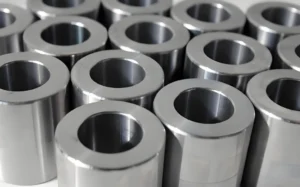
Introduction
Overview of Toroidal Core Manufacturing
Toroidal core manufacturing processes are crucial in the production of components vital to numerous electrical applications. These processes encompass the creation of donut-shaped magnetic cores, integral in transformers, inductors, and various electromagnetic devices. By focusing on toroidal core manufacturing, engineers optimize magnetic efficiency and minimize electromagnetic interference, enhancing the performance of electrical systems.
Importance of Toroidal Core Manufacturing in Electrical Applications
The manufacturing process of toroidal cores is crucial for their performance and reliability. High-quality manufacturing ensures that the cores exhibit the desired magnetic properties and mechanical strength. This is vital for applications in power electronics, telecommunications, and various industrial systems, where efficiency and performance are paramount.
Material Selection in Toroidal Core Manufacturing
Types of Materials Used
Grain-Oriented Electrical Steel: Explanation of grain-oriented electrical steel as a common material choice for toroidal cores due to its high magnetic permeability and low core losses.
Amorphous Metals: Description of amorphous metals as an alternative material offering low core losses and improved efficiency, suitable for high-frequency applications.
Ferrite Materials: Overview of ferrite materials known for their high electrical resistance and magnetic properties, often used in low-power applications and high-frequency transformers.
Criteria for Material Selection
Magnetic Properties: Discuss the importance of selecting materials with specific magnetic characteristics tailored to the application requirements, such as high permeability for efficient energy transfer.
Cost-Effectiveness: Explanation of the need to balance material costs with performance benefits, considering factors such as initial investment, operational efficiency, and long-term reliability.
Durability: Emphasize the significance of choosing materials that withstand mechanical stress, temperature variations, and environmental conditions to ensure the longevity and reliability of toroidal cores.
Core Winding Process
Preparation of Core Materials
Explanation of the preparation steps involved in preparing core materials for winding, including cutting and shaping the magnetic core material to the desired dimensions and ensuring proper surface treatment for improved winding adhesion and insulation.
Winding Techniques
Continuous Winding: Description of continuous winding technique, where the wire is wound continuously around the toroidal core without interruption, ensuring a seamless and uniform winding layer.
Segmental Winding: Explanation of segmental winding method, where the wire is wound in sections or segments around the core, allowing for easier handling and precise control over the winding process, especially for large toroidal cores.
Ensuring Uniform Winding and Tension Control
Maintaining uniform winding throughout the winding process is crucial for optimizing magnetic performance and minimizing losses. Tension control mechanisms are employed to ensure consistent tension levels across the winding, preventing wire slack or over-tensioning that may affect winding quality and core performance.
Annealing and Heat Treatment
Purpose of Annealing
Explanation of the annealing process and its purpose in toroidal core manufacturing. Annealing is essential for relieving internal stresses, improving magnetic properties, and enhancing the core’s crystalline structure for optimal performance.
Heat Treatment Procedures
The heat treatment procedures in toroidal core manufacturing involve heating cores to specific temperatures and durations to achieve desired material properties. This includes stress relief annealing, recrystallization annealing, and tempering to enhance core stability and magnetic characteristics.
Effects on Magnetic Properties
Discussion on the effects of annealing and heat treatment on the magnetic properties of toroidal cores. Highlight how these processes can alter the magnetic permeability, coercivity, and saturation magnetization of the core material, ultimately influencing its efficiency, performance, and reliability in electrical applications.
Insulation and Coating
Types of Insulation Used
Varnish: Varnish is a common insulation material in toroidal core manufacturing. It coats winding wire and core surfaces, offering electrical insulation and shielding against moisture and environmental contaminants.
Epoxy: Description of epoxy as another insulation option for toroidal cores. Epoxy coatings provide superior adhesion and mechanical strength, forming a durable insulation layer that enhances core reliability and withstands harsh operating conditions.
Application Methods
Dipping: The dipping method is commonly used for applying insulation to toroidal cores. Cores are dipped in varnish or epoxy, excess material drips off, ensuring uniform coverage and penetration into gaps. This guarantees consistent insulation, optimizing performance and reliability in electrical applications.
Spraying: The spraying technique entails using specialized equipment to spray insulation material onto toroidal cores. This method offers precise control over thickness and distribution. Consequently, it is ideal for large-scale production and complex core geometries.
Ensuring Electrical Isolation
In toroidal core manufacturing, ensuring electrical isolation is crucial. This prevents short circuits and enhances transformer performance. Insulation materials like varnish or epoxy are applied using dipping or spraying methods. Consequently, effective electrical isolation is achieved, ensuring core integrity in electrical applications.
Assembly and Testing
Assembly Techniques
Core Assembly: Core assembly techniques in toroidal core manufacturing involve precise placement and alignment of core halves or segments. This forms a complete toroidal core structure. Proper assembly ensures uniform magnetic flux distribution. Consequently, the transformer achieves optimal performance.
Bobbin Placement: Explanation of the process of placing the bobbin within the toroidal core and securing it in position. Bobbin placement is critical for maintaining winding alignment and tension, which directly impact transformer efficiency and reliability.
Quality Testing
Magnetic Testing: Overview of magnetic testing procedures conducted on toroidal cores to assess magnetic properties such as permeability, hysteresis, and coercivity. Magnetic testing ensures that the cores meet specified performance criteria and exhibit the desired magnetic characteristics for efficient energy transfer.
Electrical Testing: Description of electrical testing methods used to evaluate the insulation integrity and electrical properties of toroidal cores. This may include insulation resistance testing, dielectric strength testing, and continuity testing to ensure proper electrical isolation and prevent electrical faults.
Mechanical Testing: Explanation of mechanical testing procedures to assess the structural integrity and mechanical strength of toroidal cores. Mechanical tests may include tensile strength testing, impact resistance testing, and dimensional accuracy measurements to verify core stability and durability under various operating conditions.
By employing rigorous assembly techniques and comprehensive quality testing procedures, manufacturers can ensure the reliability, performance, and safety of toroidal cores in electrical applications.